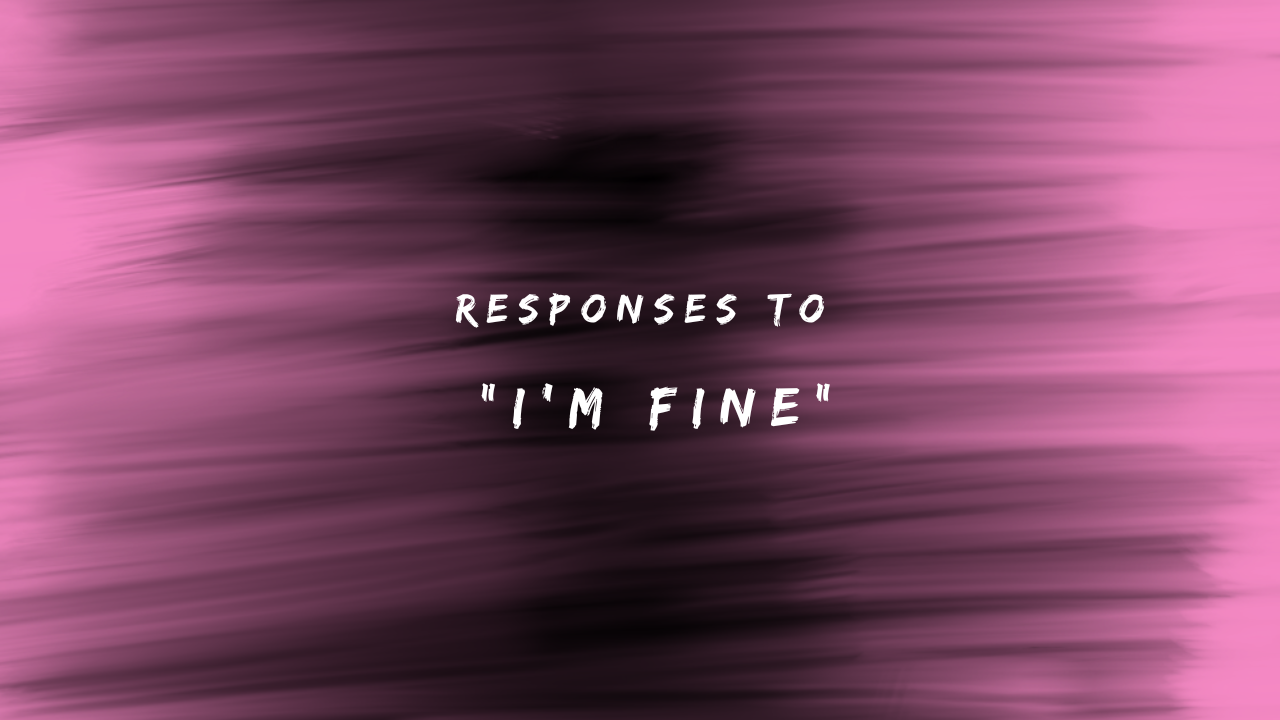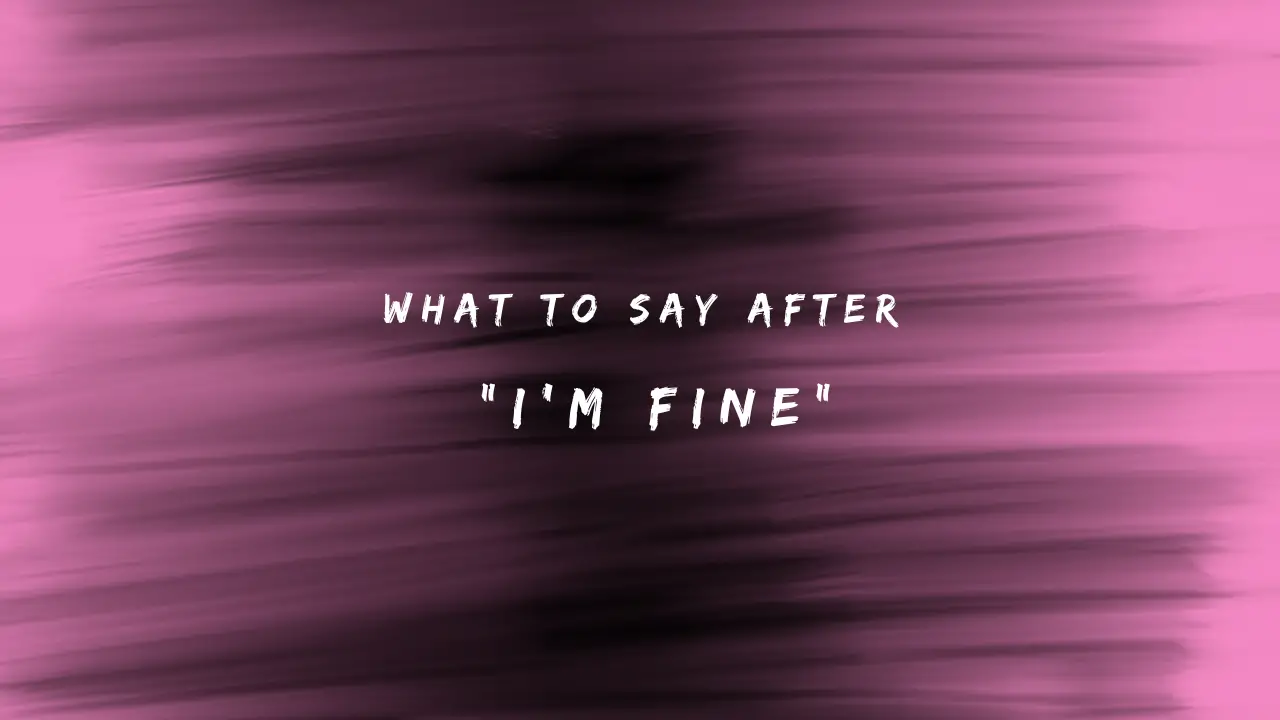Have you ever found yourself on the receiving end of a calm “I’m fine,” only to be left wondering if there’s more beneath the surface? It’s a common scenario—someone responds with “I’m fine,” but you sense something deeper might be happening. Understanding how to navigate these situations effectively can make all the difference in fostering genuine connections and providing meaningful support.

150+ Responses to “I’m Fine”
Supportive Responses
- I’m glad to hear that. If you need anything, just let me know.
- That’s good to know. I’m here if you need to talk.
- I’m happy you’re okay. Remember, I’m just a call away.
- I’m here for you, no matter what.
- It’s great to hear you’re doing alright. If you need anything, don’t hesitate to ask.
- If you need someone to lean on, I’m here for you.
- I’m glad you’re fine. Let me know if there’s anything I can do.
- You’ve got my support, always.
- It’s good to hear you’re managing. I’m here if you need to chat.
- Thanks for letting me know. I’m here if you need anything.
Encouraging Responses
- Great to hear! Keep up the good work!
- I’m glad you’re fine. Stay strong!
- That’s the spirit! Keep pushing forward!
- You’re doing great. Keep it up!
- I’m happy to hear that. Keep staying positive!
- It’s good to hear you’re holding it together. Keep going!
- You’ve got this! Glad to hear you’re okay.
- It’s wonderful to hear that you’re fine. Keep up the good attitude!
- Glad you’re feeling alright. Keep being awesome!
- It’s good to hear you’re doing well. Keep moving forward!
Curious Responses
- Are you sure? You don’t seem completely convinced.
- Really? You don’t seem entirely okay to me.
- What makes you say you’re fine? You seem a bit off.
- Is everything alright? You don’t look like yourself.
- There might be more to it. Are you sure you’re fine?
- You seem a little down. Are you okay?
- Is there something you’re not telling me? You seem a bit off.
- You don’t look like you’re feeling fine. Want to talk about it?
- I’m sensing something’s off. Are you really alright?
- You seem quiet. Is everything okay with you?
Dismissive Responses
- Okay, if you say so.
- Alright.
- Fine then.
- If you’re sure, then I’ll take your word for it.
- Got it. Moving on.
- Well, that’s good to hear.
- Alright, as long as you’re fine.
- Okay, then.
- That’s cool.
- Fine, if that’s how you feel.
Reassuring Responses
- It’s okay not to be okay. You can talk to me if you need to.
- If anything bothers you, you don’t have to handle it alone.
- It’s alright to feel however you’re feeling. I’m here for you.
- You don’t have to be fine all the time. It’s okay to open up.
- I understand that ‘fine’ can mean different things. I’m here if you need me.
- It’s okay to have days when you’re not great. I’m here for you.
- Just remember, you don’t have to go through things alone.
- I’m here to listen if you need to talk more about it.
- It’s alright if you’re not feeling 100%. I’m here to support you.
- You can always share more if you’re comfortable. I’m here for you.
Humorous Responses
- Fine? Like ‘fine’ or ‘fine’?
- Well, if ‘fine’ is your best, I’m impressed!
- Are you ‘fine’ or ‘fine’ fine? There’s a difference!
- Are you fine? That’s a relief. I was worried you’d need a superhero!
- Oh, ‘fine’? That’s my favorite four-letter word!
- If you’re ‘fine,’ I guess everything’s under control!
- Are you fine? Good to hear! I was just about to call in the backup team!
- Fine, like ‘I’m fine’ or ‘I’m fine’ with a little extra emphasis?
- Glad to hear you’re ‘fine.’ I was getting ready for a pep talk!
- You’re ‘fine’? Well, that’s better than ‘not fine,’ right?
Empathetic Responses
- I understand. Sometimes, just saying ‘fine’ is easier.
- It’s alright. Everyone has those days when they say they’re fine but aren’t quite.
- Sometimes, it’s hard to talk about how we feel. I’m here for you.
- I get it. Sometimes, it’s easier to say you’re fine than to explain your feelings.
- It’s okay to say you’re fine even if you’re not. Just know I’m here if you need to share.
- I know it can be tough to open up. I’m here if you need to talk more.
- Sometimes, ‘fine’ is the best way to get through the day. I’m here if you need to vent.
- I can understand why you’d say you’re fine even if you’re not. I’m here to listen if you want.
- Keeping things to yourself is okay if you’re not ready to talk. I’m still here for you.
- I know it’s not always easy to express how you’re feeling. Just remember, I’m here for you.
Inquisitive Follow-Up Responses
- Is there anything specific that’s been on your mind lately?
- Can you tell me more about what’s going on?
- What’s been happening that makes you say you’re fine?
- Is everything okay, or is there something else you want to discuss?
- How have you been feeling overall? Anything you want to share?
- Are you handling everything well, or is something bothering you?
- What’s been the most challenging part for you recently?
- Is there something you’d like to discuss in more detail?
- Are you sure everything’s okay? Sometimes, talking helps.
- Is there anything you’re struggling with that you want to talk about?
Reflective Responses
- It sounds like you’re putting on a brave face. How are you doing?
- Sometimes, saying ‘fine’ is a way to avoid delving into deeper feelings.
- It’s interesting how we often say we’re fine even when there’s more going on.
- I can tell you’re handling things, but I wonder if you’re okay.
- You’re managing, but sometimes, being ‘fine’ can be more complex.
- Saying you’re ‘fine’ can mean a lot of different things. How are you feeling?
- It’s good that you’re saying you’re fine, but I wonder if you’re keeping something back.
- You seem to be holding it together. I hope you’re genuinely okay.
- Sometimes, we say we’re fine with avoiding going into details. Are you sure you’re alright?
- It’s often easier to say ‘fine’ than express our feelings.
Neutral Responses
- Got it.
- Okay.
- Understood.
- Alright.
- Noted.
- Okay then.
- Thanks for letting me know.
- Alright, thanks for the update.
- I see.
- Okay, thanks.
Affirmative Responses
- Great to hear!
- I’m glad you’re fine!
- That’s good to hear.
- Awesome!
- Perfect!
- That’s great news!
- Glad to hear that!
- Good to know!
- That’s fantastic!
- I’m happy you’re doing well!
Acknowledging Responses
- Thanks for letting me know.
- I got it, thanks.
- I appreciate you sharing that.
- Noted. I’m here if you need anything.
- Thanks for the update.
- Okay, I understand.
- Thanks for keeping me informed.
- I appreciate your response.
- Alright, I acknowledge that.
- Thank you for letting me know.
Reassuring but Lighthearted Responses
- Are you fine? Great! If you need anything, just give me a shout.
- Glad to hear you’re fine! If you need a distraction, I’m here!
- It’s awesome that you’re doing well. Remember, I’m just a call away for anything!
- Are you fine? Good to know! I’m here if you need a break or a laugh.
- I’m happy to hear that. If you need anything to make you even ‘finer,’ just let me know!
- Good to hear you’re fine. Let me know if you need a little cheerleading!
- Glad you’re doing alright! If you need a mood boost, I’m here!
- It’s great you’re fine. If you want to share or just hang out, I’m available!
- Are you fine? Perfect! I’m here if you need any help or want to chat.
- Awesome that you’re okay. Remember, I’m here for a laugh or a chat anytime!
Practical Responses
- Is there anything you need help with right now?
- Do you need assistance with anything specific?
- If there’s anything you need to handle, let me know.
- Are there any tasks you need help with today?
- If there’s something practical you need support with, just say so.
- Is there anything on your to-do list that I can help with?
- Let me know if there’s something you need to get done.
- Do you need any help with your current projects or tasks?
- If you need assistance with anything practical, I’m here to help.
- Let me know if there’s something you need to take care of.
Reflective and Insightful Responses
- Sometimes, ‘fine’ is a way of coping with deeper issues. Is there something more you’re reflecting on?
- Interestingly, we often say we’re fine even when we’re not. What does ‘fine’ mean to you right now?
- Reflecting on how we say we’re fine can reveal more about our inner state. How do you feel beneath the surface?
- How we respond with ‘fine’ can signal how we manage our emotions. What’s your insight on this?
- It’s worth considering what ‘fine’ means in our lives. What’s your perspective on your current state?
- Saying you’re fine might mask deeper feelings. What insights have you gained about your own emotions?
- Reflecting on the ‘fine’ response can help us understand our emotional state better. What do you think you’re feeling?
- Our use of ‘fine’ can be a way to navigate complex feelings. What deeper thoughts are you having about this?
- ‘Fine’ often has layers beneath it. How do you perceive your feelings in this context?
- Considering what ‘fine’ means can offer insight into your emotional well-being. What are your thoughts on this?
The Complexity Behind “I’m Fine”
“I’m fine” might seem like a straightforward answer, but it’s often a facade concealing a myriad of emotions or issues. People use this phrase for various reasons—sometimes to protect themselves from vulnerability, sometimes out of habit, or even to avoid further probing. Recognizing the layers behind this simple phrase is crucial for effective communication.
Why It’s Important to Dig Deeper
Ignoring the subtle cues behind “I’m fine” can lead to misunderstandings and missed opportunities to offer support. By delving deeper, you can better understand the person’s true feelings and provide the help or reassurance they might need.
Understanding the Context of “I’m Fine”
- The Psychological Aspect
From a psychological standpoint, “I’m fine” can be a defense mechanism. People often use it to shield themselves from discomfort or to avoid confronting their emotions directly. It’s saying, “I don’t want to discuss it,” or “I’m not ready to open up.”
- Cultural and Social Implications
Culturally, the way people respond to inquiries about their well-being can vary. In some cultures, admitting to struggling might be seen as a sign of weakness, hence the preference for saying, “I’m fine.” Understanding these cultural nuances can help you approach the conversation with greater sensitivity.
- Different Situations Where “I’m Fine” Might Be Used
“I’m fine” can be used in various contexts—when someone feels overwhelmed, under stress, or doesn’t want to discuss their problems. The context in which it’s used often provides clues about the person’s feelings.
Why People Say “I’m Fine”
- Common Reasons Behind the Phrase
People might say “I’m fine” for reasons such as not wanting to burden others, fearing judgment, or simply not having the words to articulate their feelings. It’s a way of maintaining a semblance of control and normalcy.
- Misconceptions About “I’m Fine”
There’s a common misconception that if someone says, “I’m fine,” they truly are. However, this isn’t always the case. Sometimes, “I’m fine” is a way of closing off a conversation rather than genuinely expressing well-being.
How to Respond to “I’m Fine”
- When to Push for More Information
If you suspect that “I’m fine” is a cover for something deeper, it’s okay to encourage the person to share more gently. Use open-ended questions and show genuine concern without being forceful.
- When to Respect Boundaries
Not everyone is ready or willing to discuss their feelings. If someone indicates that they’re fine and don’t want to talk, respecting their boundaries and letting them know you’re there whenever they’re ready is important.
- Using Empathy and Active Listening
Empathy and active listening are crucial. Show that you care by listening attentively and validating their feelings. Sometimes, knowing that someone is truly listening can make a difference.
Navigating Sensitive Conversations
- Recognizing Non-Verbal Cues
Often, non-verbal cues can reveal more than words. Pay attention to body language, tone of voice, and facial expressions, which give insight into how the person feels.
- Balancing Between Care and Intrusiveness
Finding the right balance between showing you care and respecting privacy is key. Avoid pressing too hard, but let them know you can listen if they open up.
Building Trust and Communication Skills
- The Role of Trust in Communication
Building trust is fundamental in any relationship. When people trust you, they’re more likely to be honest about their feelings. Establishing trust involves being consistent, respectful, and supportive.
- Improving Your Communication Skills
Effective communication isn’t just about talking but listening and responding thoughtfully. Practice active listening, avoid interrupting, and ensure your responses are empathetic and supportive.
Conclusion
In conclusion, knowing how to respond when someone says, “I’m fine,” can significantly affect the depth and quality of your conversations. Using the 150+ responses in this guide, you can navigate these interactions with greater empathy and understanding, fostering more meaningful connections. Effective communication is a two-way street; showing genuine interest can lead to more open and honest dialogues. If you’re looking for additional ways to enhance your conversational skills,
Check out our guide on:
How to Reply to “That’s Good To Hear”: 150+ Replies
FAQs
Q. What if someone insists they’re fine but isn’t?
If someone repeatedly insists they’re fine but seems distressed, approach them gently and tell them you’re available whenever they’re ready to talk. Sometimes, just knowing someone cares can be comforting.
Q. How can I encourage someone to talk if they don’t want to?
Use open-ended questions and affirming statements to create a safe space for them to share. Ensure they know you’re there for them without pressuring them to open up.
Q. Are there ways to address this issue in a professional setting?
Yes, approach the topic with sensitivity and professionalism. Offer support and a listening ear, and respect their boundaries. Maintaining a balance between providing support and maintaining professional boundaries is important.
Q. How can I differentiate between a genuine “I’m Fine” and a protective facade?
Look for non-verbal cues and context. If the person seems off or avoids eye contact, it might indicate they’re not being honest. However, always approach with empathy and respect.
Q. What should I do to effectively respond to “I’m Fine”?
Reflect on your responses and consider seeking feedback from trusted friends or colleagues. Practice active listening and empathy, and remember that being supportive sometimes means just being there without forcing a conversation.











Technoob Very well presented. Every quote was awesome and thanks for sharing the content. Keep sharing and keep motivating others.
GlobalBllog very informative articles or reviews at this time.